Business Finance Report: Budgeting Methods, Applications and Analysis
VerifiedAdded on 2020/12/09
|12
|3997
|339
Report
AI Summary
This report delves into the realm of business finance, focusing on the purpose and process of budgeting within an organization. It begins by defining budgeting and its significance in financial operations, emphasizing its role in planning, control, and long-term strategy. The report then outlines the budgeting process, including strategic planning, goal setting, revenue projections, cost analysis, and budget review. Part 1 further examines traditional budgeting approaches, including incremental budgeting, and evaluates its applications, such as providing a concrete framework, encouraging decentralization, and impacting organizational culture. Part 2 then introduces alternative budgeting methods, such as rolling budgets and zero-based budgeting, along with their applications. The report concludes by evaluating the suitability of different methods for future business operations, providing a comprehensive analysis of budgeting strategies for effective financial management. The report is designed to provide insights on budgeting methods, applications and analysis.
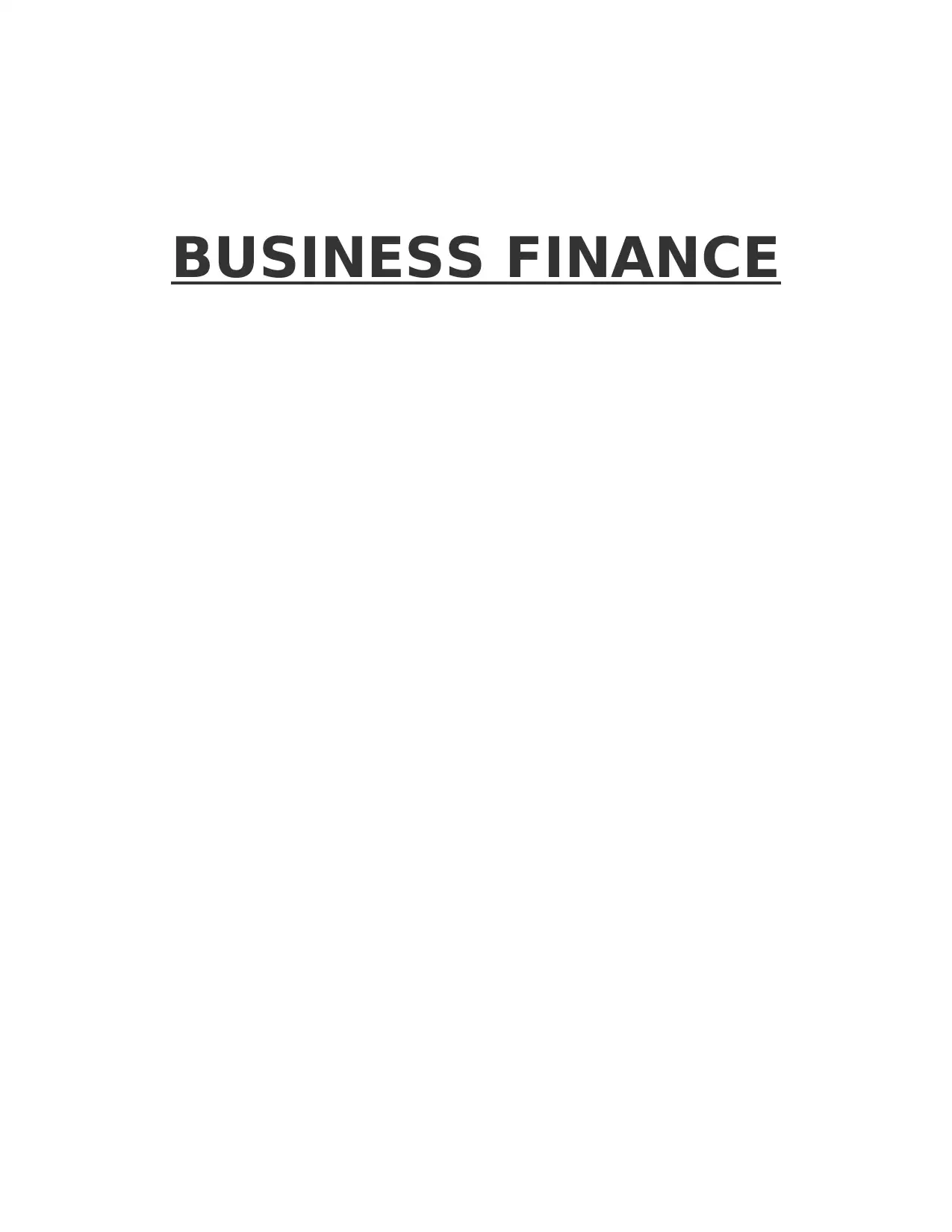
BUSINESS FINANCE
Paraphrase This Document
Need a fresh take? Get an instant paraphrase of this document with our AI Paraphraser
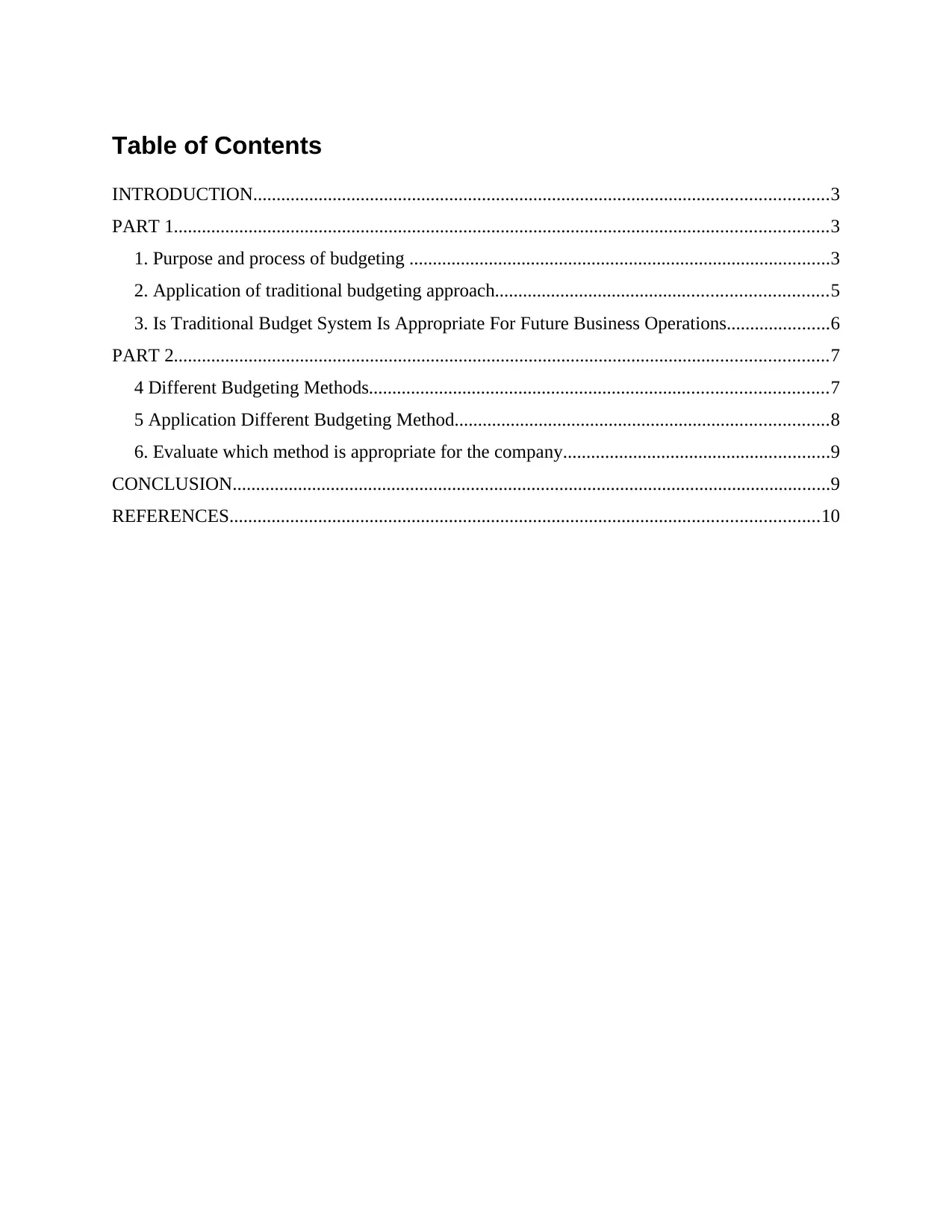
Table of Contents
INTRODUCTION...........................................................................................................................3
PART 1............................................................................................................................................3
1. Purpose and process of budgeting ..........................................................................................3
2. Application of traditional budgeting approach.......................................................................5
3. Is Traditional Budget System Is Appropriate For Future Business Operations......................6
PART 2............................................................................................................................................7
4 Different Budgeting Methods..................................................................................................7
5 Application Different Budgeting Method................................................................................8
6. Evaluate which method is appropriate for the company.........................................................9
CONCLUSION................................................................................................................................9
REFERENCES..............................................................................................................................10
INTRODUCTION...........................................................................................................................3
PART 1............................................................................................................................................3
1. Purpose and process of budgeting ..........................................................................................3
2. Application of traditional budgeting approach.......................................................................5
3. Is Traditional Budget System Is Appropriate For Future Business Operations......................6
PART 2............................................................................................................................................7
4 Different Budgeting Methods..................................................................................................7
5 Application Different Budgeting Method................................................................................8
6. Evaluate which method is appropriate for the company.........................................................9
CONCLUSION................................................................................................................................9
REFERENCES..............................................................................................................................10
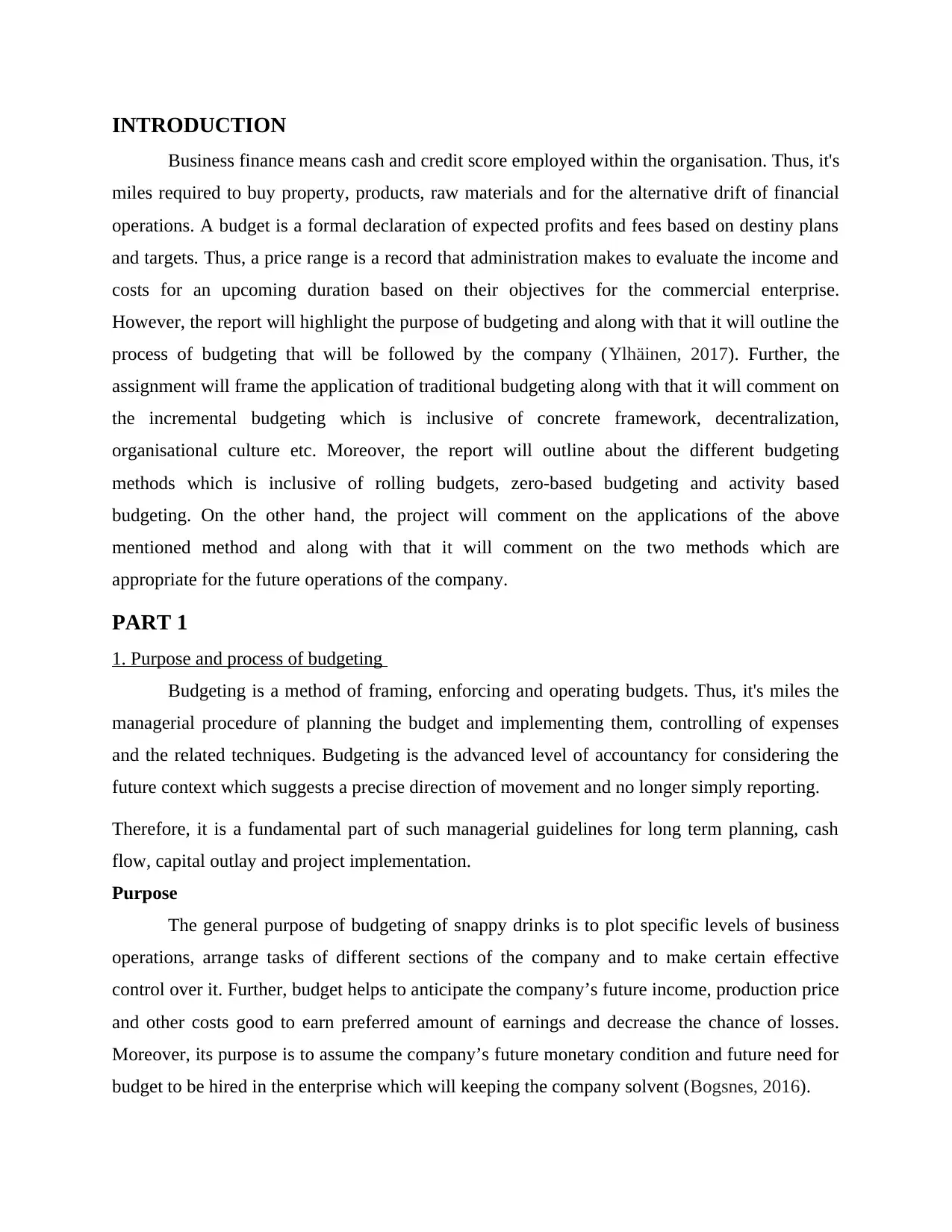
INTRODUCTION
Business finance means cash and credit score employed within the organisation. Thus, it's
miles required to buy property, products, raw materials and for the alternative drift of financial
operations. A budget is a formal declaration of expected profits and fees based on destiny plans
and targets. Thus, a price range is a record that administration makes to evaluate the income and
costs for an upcoming duration based on their objectives for the commercial enterprise.
However, the report will highlight the purpose of budgeting and along with that it will outline the
process of budgeting that will be followed by the company (Ylhäinen, 2017). Further, the
assignment will frame the application of traditional budgeting along with that it will comment on
the incremental budgeting which is inclusive of concrete framework, decentralization,
organisational culture etc. Moreover, the report will outline about the different budgeting
methods which is inclusive of rolling budgets, zero-based budgeting and activity based
budgeting. On the other hand, the project will comment on the applications of the above
mentioned method and along with that it will comment on the two methods which are
appropriate for the future operations of the company.
PART 1
1. Purpose and process of budgeting
Budgeting is a method of framing, enforcing and operating budgets. Thus, it's miles the
managerial procedure of planning the budget and implementing them, controlling of expenses
and the related techniques. Budgeting is the advanced level of accountancy for considering the
future context which suggests a precise direction of movement and no longer simply reporting.
Therefore, it is a fundamental part of such managerial guidelines for long term planning, cash
flow, capital outlay and project implementation.
Purpose
The general purpose of budgeting of snappy drinks is to plot specific levels of business
operations, arrange tasks of different sections of the company and to make certain effective
control over it. Further, budget helps to anticipate the company’s future income, production price
and other costs good to earn preferred amount of earnings and decrease the chance of losses.
Moreover, its purpose is to assume the company’s future monetary condition and future need for
budget to be hired in the enterprise which will keeping the company solvent (Bogsnes, 2016).
Business finance means cash and credit score employed within the organisation. Thus, it's
miles required to buy property, products, raw materials and for the alternative drift of financial
operations. A budget is a formal declaration of expected profits and fees based on destiny plans
and targets. Thus, a price range is a record that administration makes to evaluate the income and
costs for an upcoming duration based on their objectives for the commercial enterprise.
However, the report will highlight the purpose of budgeting and along with that it will outline the
process of budgeting that will be followed by the company (Ylhäinen, 2017). Further, the
assignment will frame the application of traditional budgeting along with that it will comment on
the incremental budgeting which is inclusive of concrete framework, decentralization,
organisational culture etc. Moreover, the report will outline about the different budgeting
methods which is inclusive of rolling budgets, zero-based budgeting and activity based
budgeting. On the other hand, the project will comment on the applications of the above
mentioned method and along with that it will comment on the two methods which are
appropriate for the future operations of the company.
PART 1
1. Purpose and process of budgeting
Budgeting is a method of framing, enforcing and operating budgets. Thus, it's miles the
managerial procedure of planning the budget and implementing them, controlling of expenses
and the related techniques. Budgeting is the advanced level of accountancy for considering the
future context which suggests a precise direction of movement and no longer simply reporting.
Therefore, it is a fundamental part of such managerial guidelines for long term planning, cash
flow, capital outlay and project implementation.
Purpose
The general purpose of budgeting of snappy drinks is to plot specific levels of business
operations, arrange tasks of different sections of the company and to make certain effective
control over it. Further, budget helps to anticipate the company’s future income, production price
and other costs good to earn preferred amount of earnings and decrease the chance of losses.
Moreover, its purpose is to assume the company’s future monetary condition and future need for
budget to be hired in the enterprise which will keeping the company solvent (Bogsnes, 2016).
⊘ This is a preview!⊘
Do you want full access?
Subscribe today to unlock all pages.

Trusted by 1+ million students worldwide
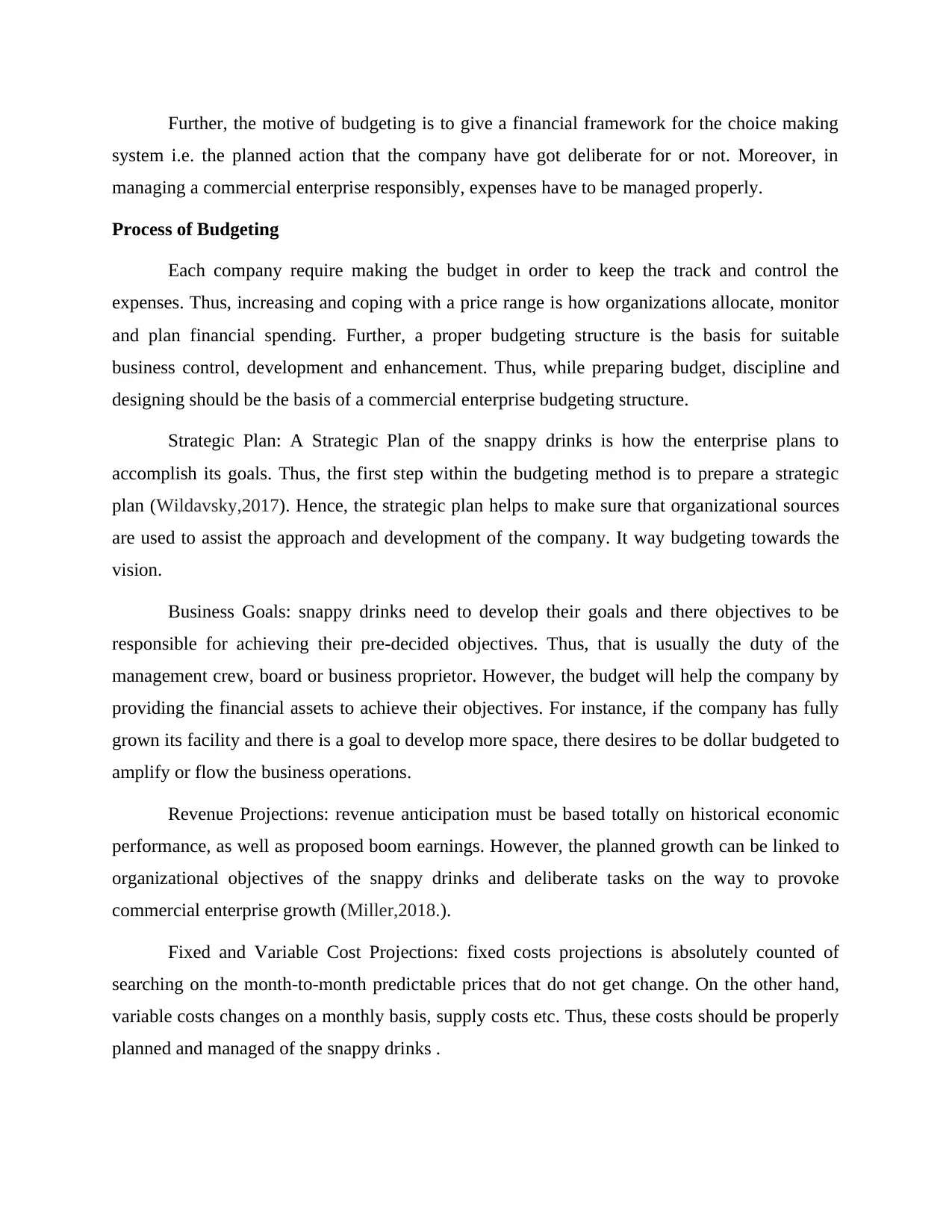
Further, the motive of budgeting is to give a financial framework for the choice making
system i.e. the planned action that the company have got deliberate for or not. Moreover, in
managing a commercial enterprise responsibly, expenses have to be managed properly.
Process of Budgeting
Each company require making the budget in order to keep the track and control the
expenses. Thus, increasing and coping with a price range is how organizations allocate, monitor
and plan financial spending. Further, a proper budgeting structure is the basis for suitable
business control, development and enhancement. Thus, while preparing budget, discipline and
designing should be the basis of a commercial enterprise budgeting structure.
Strategic Plan: A Strategic Plan of the snappy drinks is how the enterprise plans to
accomplish its goals. Thus, the first step within the budgeting method is to prepare a strategic
plan (Wildavsky,2017). Hence, the strategic plan helps to make sure that organizational sources
are used to assist the approach and development of the company. It way budgeting towards the
vision.
Business Goals: snappy drinks need to develop their goals and there objectives to be
responsible for achieving their pre-decided objectives. Thus, that is usually the duty of the
management crew, board or business proprietor. However, the budget will help the company by
providing the financial assets to achieve their objectives. For instance, if the company has fully
grown its facility and there is a goal to develop more space, there desires to be dollar budgeted to
amplify or flow the business operations.
Revenue Projections: revenue anticipation must be based totally on historical economic
performance, as well as proposed boom earnings. However, the planned growth can be linked to
organizational objectives of the snappy drinks and deliberate tasks on the way to provoke
commercial enterprise growth (Miller,2018.).
Fixed and Variable Cost Projections: fixed costs projections is absolutely counted of
searching on the month-to-month predictable prices that do not get change. On the other hand,
variable costs changes on a monthly basis, supply costs etc. Thus, these costs should be properly
planned and managed of the snappy drinks .
system i.e. the planned action that the company have got deliberate for or not. Moreover, in
managing a commercial enterprise responsibly, expenses have to be managed properly.
Process of Budgeting
Each company require making the budget in order to keep the track and control the
expenses. Thus, increasing and coping with a price range is how organizations allocate, monitor
and plan financial spending. Further, a proper budgeting structure is the basis for suitable
business control, development and enhancement. Thus, while preparing budget, discipline and
designing should be the basis of a commercial enterprise budgeting structure.
Strategic Plan: A Strategic Plan of the snappy drinks is how the enterprise plans to
accomplish its goals. Thus, the first step within the budgeting method is to prepare a strategic
plan (Wildavsky,2017). Hence, the strategic plan helps to make sure that organizational sources
are used to assist the approach and development of the company. It way budgeting towards the
vision.
Business Goals: snappy drinks need to develop their goals and there objectives to be
responsible for achieving their pre-decided objectives. Thus, that is usually the duty of the
management crew, board or business proprietor. However, the budget will help the company by
providing the financial assets to achieve their objectives. For instance, if the company has fully
grown its facility and there is a goal to develop more space, there desires to be dollar budgeted to
amplify or flow the business operations.
Revenue Projections: revenue anticipation must be based totally on historical economic
performance, as well as proposed boom earnings. However, the planned growth can be linked to
organizational objectives of the snappy drinks and deliberate tasks on the way to provoke
commercial enterprise growth (Miller,2018.).
Fixed and Variable Cost Projections: fixed costs projections is absolutely counted of
searching on the month-to-month predictable prices that do not get change. On the other hand,
variable costs changes on a monthly basis, supply costs etc. Thus, these costs should be properly
planned and managed of the snappy drinks .
Paraphrase This Document
Need a fresh take? Get an instant paraphrase of this document with our AI Paraphraser
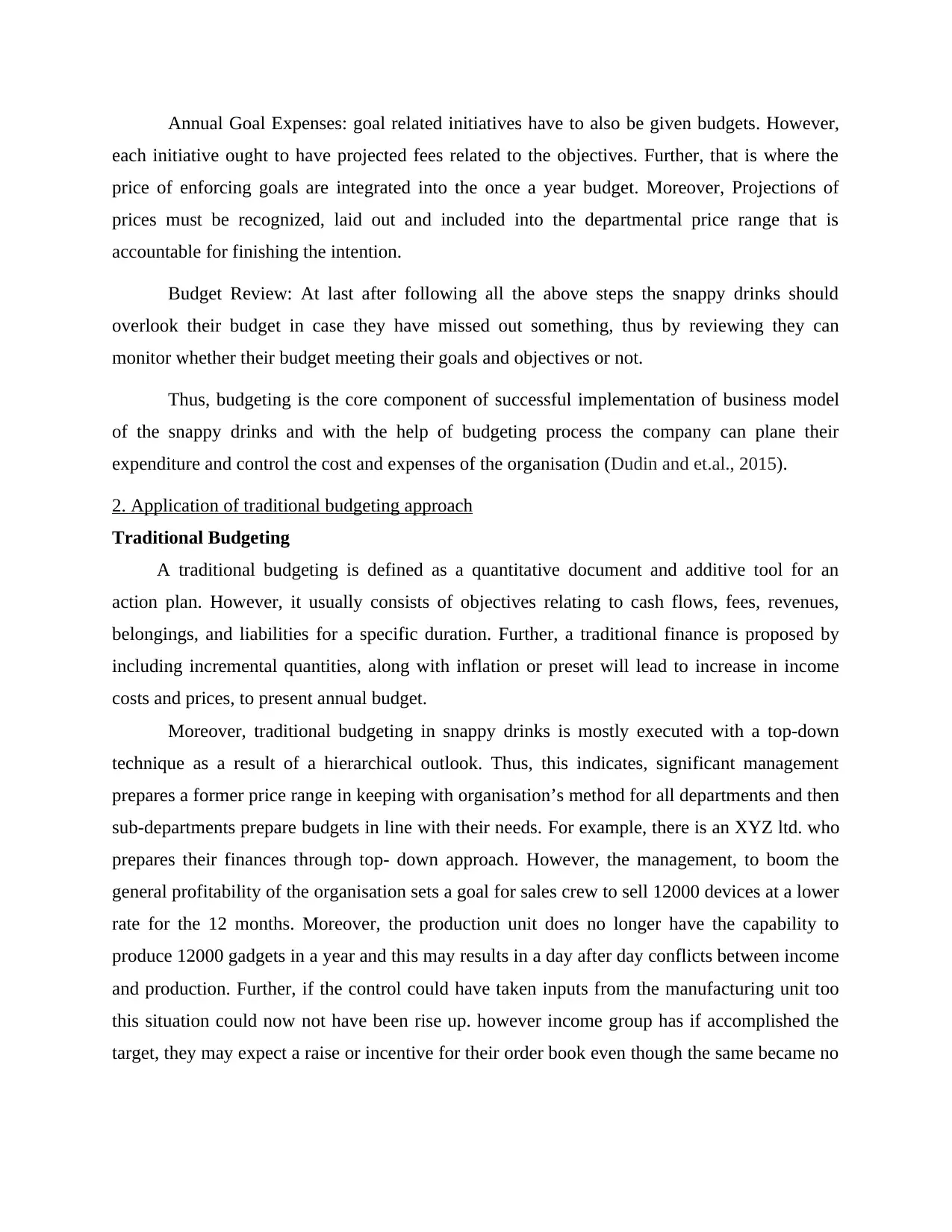
Annual Goal Expenses: goal related initiatives have to also be given budgets. However,
each initiative ought to have projected fees related to the objectives. Further, that is where the
price of enforcing goals are integrated into the once a year budget. Moreover, Projections of
prices must be recognized, laid out and included into the departmental price range that is
accountable for finishing the intention.
Budget Review: At last after following all the above steps the snappy drinks should
overlook their budget in case they have missed out something, thus by reviewing they can
monitor whether their budget meeting their goals and objectives or not.
Thus, budgeting is the core component of successful implementation of business model
of the snappy drinks and with the help of budgeting process the company can plane their
expenditure and control the cost and expenses of the organisation (Dudin and et.al., 2015).
2. Application of traditional budgeting approach
Traditional Budgeting
A traditional budgeting is defined as a quantitative document and additive tool for an
action plan. However, it usually consists of objectives relating to cash flows, fees, revenues,
belongings, and liabilities for a specific duration. Further, a traditional finance is proposed by
including incremental quantities, along with inflation or preset will lead to increase in income
costs and prices, to present annual budget.
Moreover, traditional budgeting in snappy drinks is mostly executed with a top-down
technique as a result of a hierarchical outlook. Thus, this indicates, significant management
prepares a former price range in keeping with organisation’s method for all departments and then
sub-departments prepare budgets in line with their needs. For example, there is an XYZ ltd. who
prepares their finances through top- down approach. However, the management, to boom the
general profitability of the organisation sets a goal for sales crew to sell 12000 devices at a lower
rate for the 12 months. Moreover, the production unit does no longer have the capability to
produce 12000 gadgets in a year and this may results in a day after day conflicts between income
and production. Further, if the control could have taken inputs from the manufacturing unit too
this situation could now not have been rise up. however income group has if accomplished the
target, they may expect a raise or incentive for their order book even though the same became no
each initiative ought to have projected fees related to the objectives. Further, that is where the
price of enforcing goals are integrated into the once a year budget. Moreover, Projections of
prices must be recognized, laid out and included into the departmental price range that is
accountable for finishing the intention.
Budget Review: At last after following all the above steps the snappy drinks should
overlook their budget in case they have missed out something, thus by reviewing they can
monitor whether their budget meeting their goals and objectives or not.
Thus, budgeting is the core component of successful implementation of business model
of the snappy drinks and with the help of budgeting process the company can plane their
expenditure and control the cost and expenses of the organisation (Dudin and et.al., 2015).
2. Application of traditional budgeting approach
Traditional Budgeting
A traditional budgeting is defined as a quantitative document and additive tool for an
action plan. However, it usually consists of objectives relating to cash flows, fees, revenues,
belongings, and liabilities for a specific duration. Further, a traditional finance is proposed by
including incremental quantities, along with inflation or preset will lead to increase in income
costs and prices, to present annual budget.
Moreover, traditional budgeting in snappy drinks is mostly executed with a top-down
technique as a result of a hierarchical outlook. Thus, this indicates, significant management
prepares a former price range in keeping with organisation’s method for all departments and then
sub-departments prepare budgets in line with their needs. For example, there is an XYZ ltd. who
prepares their finances through top- down approach. However, the management, to boom the
general profitability of the organisation sets a goal for sales crew to sell 12000 devices at a lower
rate for the 12 months. Moreover, the production unit does no longer have the capability to
produce 12000 gadgets in a year and this may results in a day after day conflicts between income
and production. Further, if the control could have taken inputs from the manufacturing unit too
this situation could now not have been rise up. however income group has if accomplished the
target, they may expect a raise or incentive for their order book even though the same became no
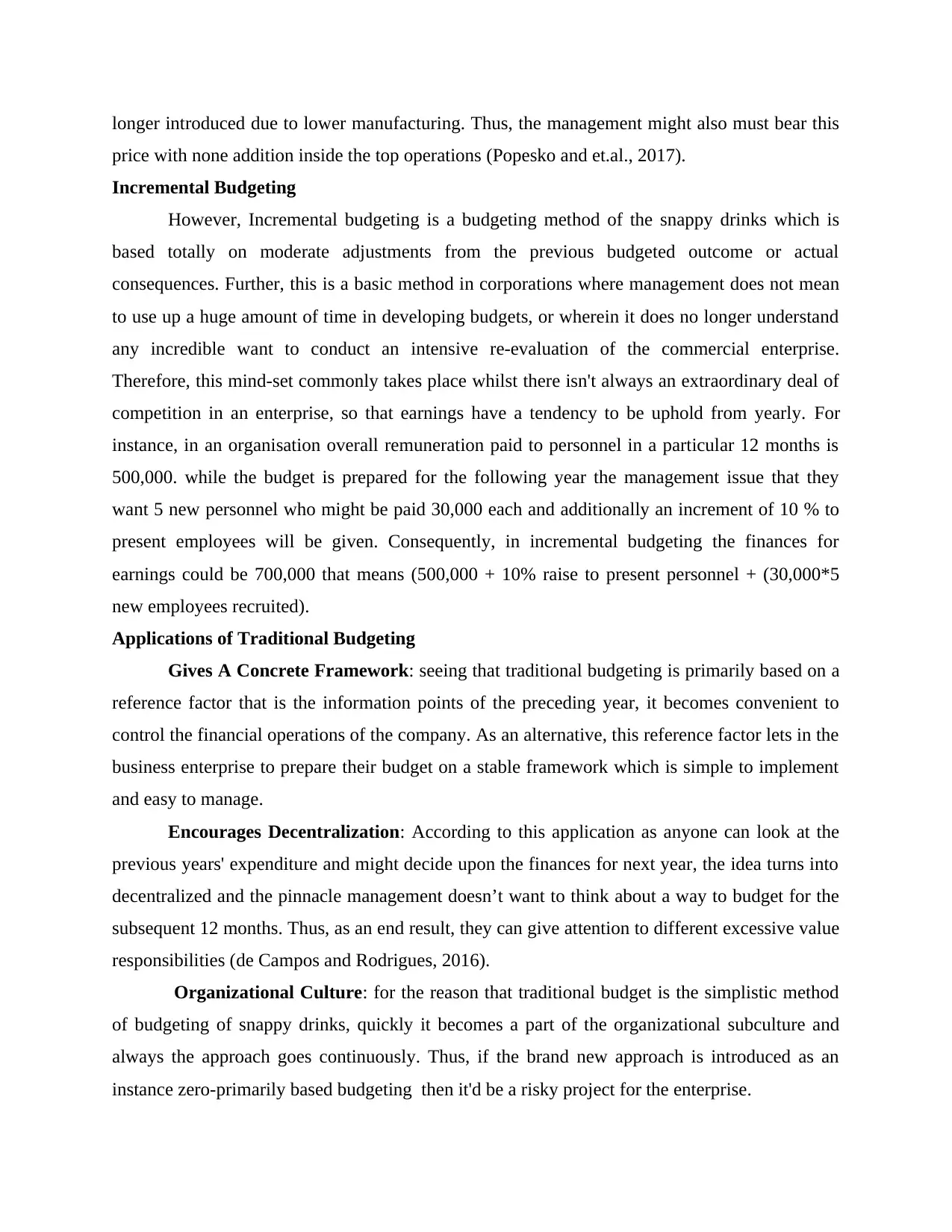
longer introduced due to lower manufacturing. Thus, the management might also must bear this
price with none addition inside the top operations (Popesko and et.al., 2017).
Incremental Budgeting
However, Incremental budgeting is a budgeting method of the snappy drinks which is
based totally on moderate adjustments from the previous budgeted outcome or actual
consequences. Further, this is a basic method in corporations where management does not mean
to use up a huge amount of time in developing budgets, or wherein it does no longer understand
any incredible want to conduct an intensive re-evaluation of the commercial enterprise.
Therefore, this mind-set commonly takes place whilst there isn't always an extraordinary deal of
competition in an enterprise, so that earnings have a tendency to be uphold from yearly. For
instance, in an organisation overall remuneration paid to personnel in a particular 12 months is
500,000. while the budget is prepared for the following year the management issue that they
want 5 new personnel who might be paid 30,000 each and additionally an increment of 10 % to
present employees will be given. Consequently, in incremental budgeting the finances for
earnings could be 700,000 that means (500,000 + 10% raise to present personnel + (30,000*5
new employees recruited).
Applications of Traditional Budgeting
Gives A Concrete Framework: seeing that traditional budgeting is primarily based on a
reference factor that is the information points of the preceding year, it becomes convenient to
control the financial operations of the company. As an alternative, this reference factor lets in the
business enterprise to prepare their budget on a stable framework which is simple to implement
and easy to manage.
Encourages Decentralization: According to this application as anyone can look at the
previous years' expenditure and might decide upon the finances for next year, the idea turns into
decentralized and the pinnacle management doesn’t want to think about a way to budget for the
subsequent 12 months. Thus, as an end result, they can give attention to different excessive value
responsibilities (de Campos and Rodrigues, 2016).
Organizational Culture: for the reason that traditional budget is the simplistic method
of budgeting of snappy drinks, quickly it becomes a part of the organizational subculture and
always the approach goes continuously. Thus, if the brand new approach is introduced as an
instance zero-primarily based budgeting then it'd be a risky project for the enterprise.
price with none addition inside the top operations (Popesko and et.al., 2017).
Incremental Budgeting
However, Incremental budgeting is a budgeting method of the snappy drinks which is
based totally on moderate adjustments from the previous budgeted outcome or actual
consequences. Further, this is a basic method in corporations where management does not mean
to use up a huge amount of time in developing budgets, or wherein it does no longer understand
any incredible want to conduct an intensive re-evaluation of the commercial enterprise.
Therefore, this mind-set commonly takes place whilst there isn't always an extraordinary deal of
competition in an enterprise, so that earnings have a tendency to be uphold from yearly. For
instance, in an organisation overall remuneration paid to personnel in a particular 12 months is
500,000. while the budget is prepared for the following year the management issue that they
want 5 new personnel who might be paid 30,000 each and additionally an increment of 10 % to
present employees will be given. Consequently, in incremental budgeting the finances for
earnings could be 700,000 that means (500,000 + 10% raise to present personnel + (30,000*5
new employees recruited).
Applications of Traditional Budgeting
Gives A Concrete Framework: seeing that traditional budgeting is primarily based on a
reference factor that is the information points of the preceding year, it becomes convenient to
control the financial operations of the company. As an alternative, this reference factor lets in the
business enterprise to prepare their budget on a stable framework which is simple to implement
and easy to manage.
Encourages Decentralization: According to this application as anyone can look at the
previous years' expenditure and might decide upon the finances for next year, the idea turns into
decentralized and the pinnacle management doesn’t want to think about a way to budget for the
subsequent 12 months. Thus, as an end result, they can give attention to different excessive value
responsibilities (de Campos and Rodrigues, 2016).
Organizational Culture: for the reason that traditional budget is the simplistic method
of budgeting of snappy drinks, quickly it becomes a part of the organizational subculture and
always the approach goes continuously. Thus, if the brand new approach is introduced as an
instance zero-primarily based budgeting then it'd be a risky project for the enterprise.
⊘ This is a preview!⊘
Do you want full access?
Subscribe today to unlock all pages.

Trusted by 1+ million students worldwide
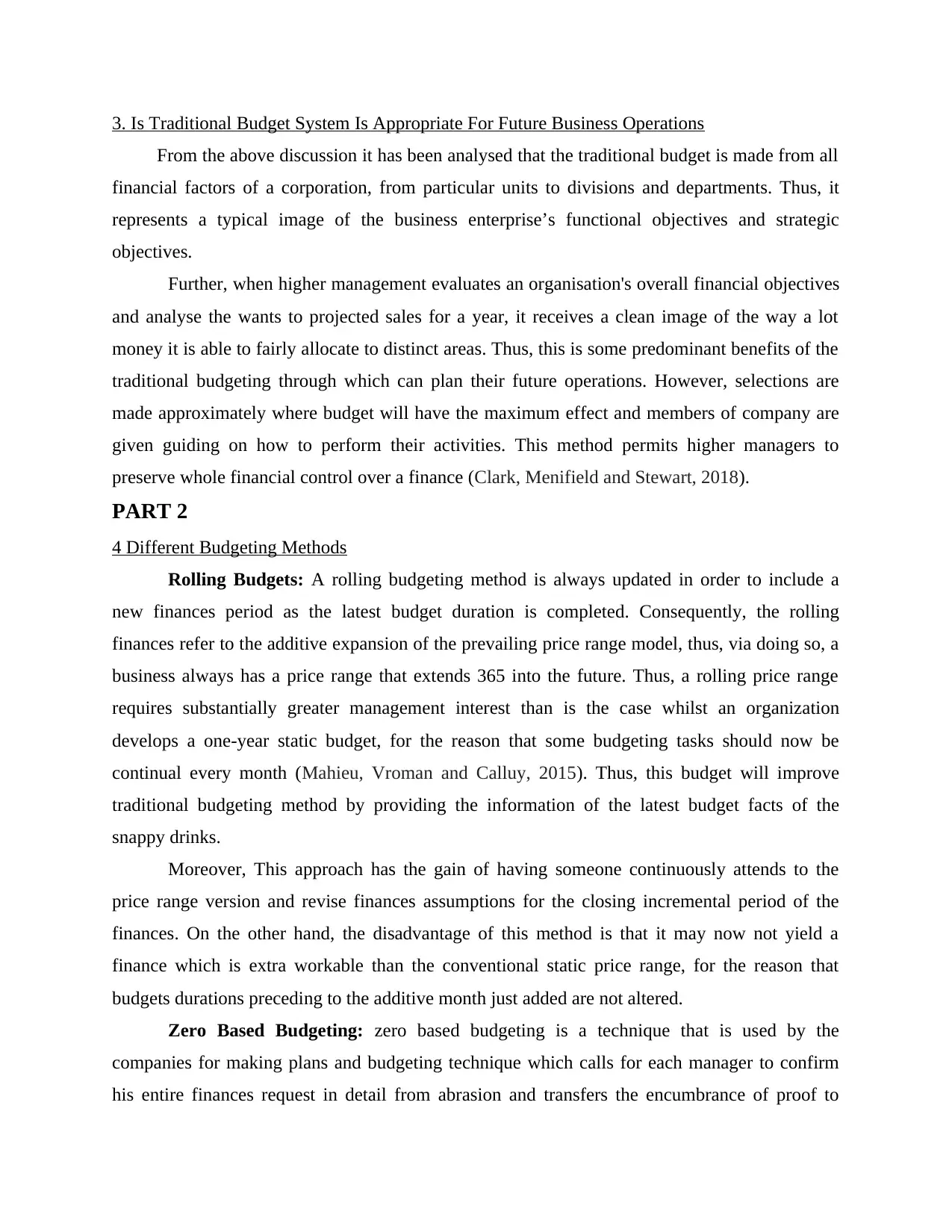
3. Is Traditional Budget System Is Appropriate For Future Business Operations
From the above discussion it has been analysed that the traditional budget is made from all
financial factors of a corporation, from particular units to divisions and departments. Thus, it
represents a typical image of the business enterprise’s functional objectives and strategic
objectives.
Further, when higher management evaluates an organisation's overall financial objectives
and analyse the wants to projected sales for a year, it receives a clean image of the way a lot
money it is able to fairly allocate to distinct areas. Thus, this is some predominant benefits of the
traditional budgeting through which can plan their future operations. However, selections are
made approximately where budget will have the maximum effect and members of company are
given guiding on how to perform their activities. This method permits higher managers to
preserve whole financial control over a finance (Clark, Menifield and Stewart, 2018).
PART 2
4 Different Budgeting Methods
Rolling Budgets: A rolling budgeting method is always updated in order to include a
new finances period as the latest budget duration is completed. Consequently, the rolling
finances refer to the additive expansion of the prevailing price range model, thus, via doing so, a
business always has a price range that extends 365 into the future. Thus, a rolling price range
requires substantially greater management interest than is the case whilst an organization
develops a one-year static budget, for the reason that some budgeting tasks should now be
continual every month (Mahieu, Vroman and Calluy, 2015). Thus, this budget will improve
traditional budgeting method by providing the information of the latest budget facts of the
snappy drinks.
Moreover, This approach has the gain of having someone continuously attends to the
price range version and revise finances assumptions for the closing incremental period of the
finances. On the other hand, the disadvantage of this method is that it may now not yield a
finance which is extra workable than the conventional static price range, for the reason that
budgets durations preceding to the additive month just added are not altered.
Zero Based Budgeting: zero based budgeting is a technique that is used by the
companies for making plans and budgeting technique which calls for each manager to confirm
his entire finances request in detail from abrasion and transfers the encumbrance of proof to
From the above discussion it has been analysed that the traditional budget is made from all
financial factors of a corporation, from particular units to divisions and departments. Thus, it
represents a typical image of the business enterprise’s functional objectives and strategic
objectives.
Further, when higher management evaluates an organisation's overall financial objectives
and analyse the wants to projected sales for a year, it receives a clean image of the way a lot
money it is able to fairly allocate to distinct areas. Thus, this is some predominant benefits of the
traditional budgeting through which can plan their future operations. However, selections are
made approximately where budget will have the maximum effect and members of company are
given guiding on how to perform their activities. This method permits higher managers to
preserve whole financial control over a finance (Clark, Menifield and Stewart, 2018).
PART 2
4 Different Budgeting Methods
Rolling Budgets: A rolling budgeting method is always updated in order to include a
new finances period as the latest budget duration is completed. Consequently, the rolling
finances refer to the additive expansion of the prevailing price range model, thus, via doing so, a
business always has a price range that extends 365 into the future. Thus, a rolling price range
requires substantially greater management interest than is the case whilst an organization
develops a one-year static budget, for the reason that some budgeting tasks should now be
continual every month (Mahieu, Vroman and Calluy, 2015). Thus, this budget will improve
traditional budgeting method by providing the information of the latest budget facts of the
snappy drinks.
Moreover, This approach has the gain of having someone continuously attends to the
price range version and revise finances assumptions for the closing incremental period of the
finances. On the other hand, the disadvantage of this method is that it may now not yield a
finance which is extra workable than the conventional static price range, for the reason that
budgets durations preceding to the additive month just added are not altered.
Zero Based Budgeting: zero based budgeting is a technique that is used by the
companies for making plans and budgeting technique which calls for each manager to confirm
his entire finances request in detail from abrasion and transfers the encumbrance of proof to
Paraphrase This Document
Need a fresh take? Get an instant paraphrase of this document with our AI Paraphraser
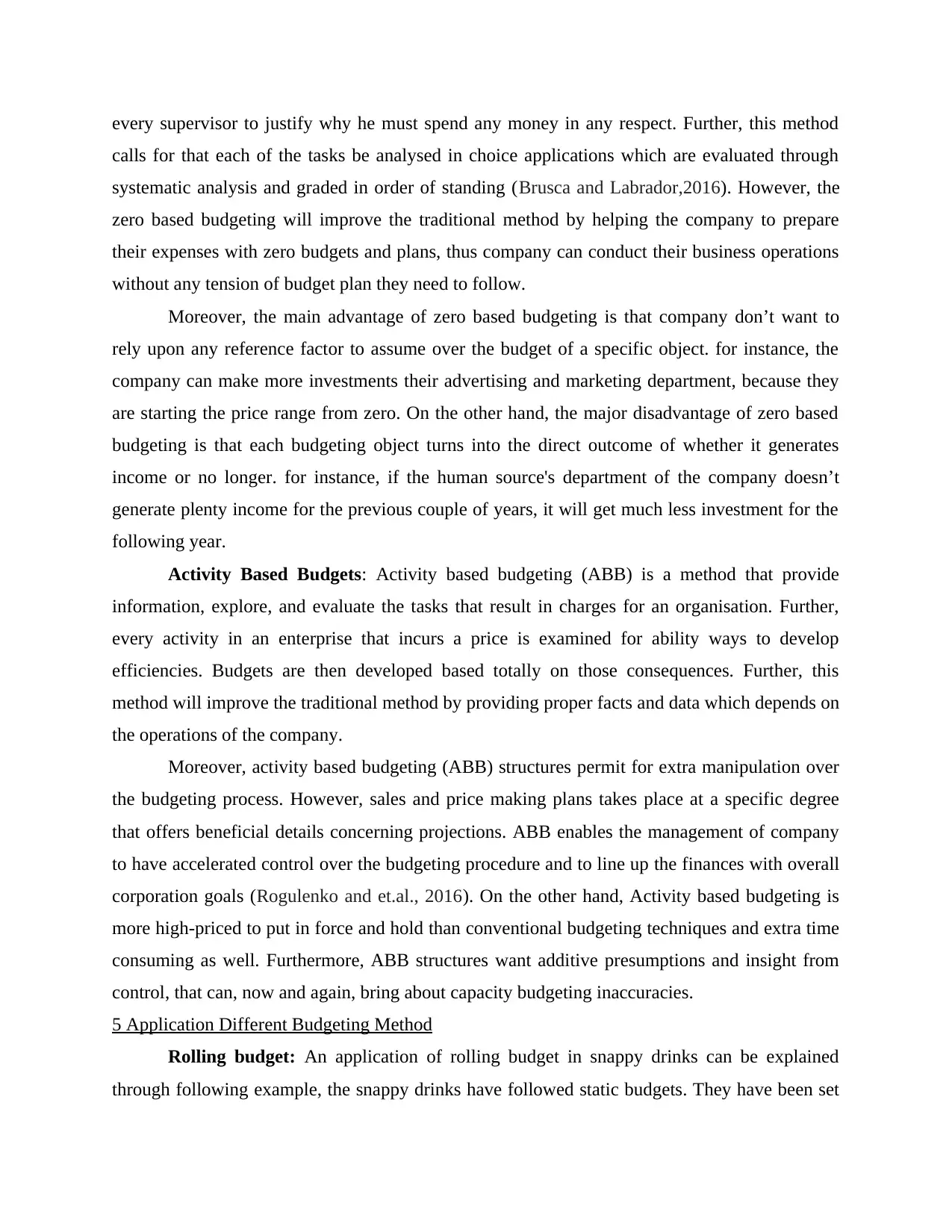
every supervisor to justify why he must spend any money in any respect. Further, this method
calls for that each of the tasks be analysed in choice applications which are evaluated through
systematic analysis and graded in order of standing (Brusca and Labrador,2016). However, the
zero based budgeting will improve the traditional method by helping the company to prepare
their expenses with zero budgets and plans, thus company can conduct their business operations
without any tension of budget plan they need to follow.
Moreover, the main advantage of zero based budgeting is that company don’t want to
rely upon any reference factor to assume over the budget of a specific object. for instance, the
company can make more investments their advertising and marketing department, because they
are starting the price range from zero. On the other hand, the major disadvantage of zero based
budgeting is that each budgeting object turns into the direct outcome of whether it generates
income or no longer. for instance, if the human source's department of the company doesn’t
generate plenty income for the previous couple of years, it will get much less investment for the
following year.
Activity Based Budgets: Activity based budgeting (ABB) is a method that provide
information, explore, and evaluate the tasks that result in charges for an organisation. Further,
every activity in an enterprise that incurs a price is examined for ability ways to develop
efficiencies. Budgets are then developed based totally on those consequences. Further, this
method will improve the traditional method by providing proper facts and data which depends on
the operations of the company.
Moreover, activity based budgeting (ABB) structures permit for extra manipulation over
the budgeting process. However, sales and price making plans takes place at a specific degree
that offers beneficial details concerning projections. ABB enables the management of company
to have accelerated control over the budgeting procedure and to line up the finances with overall
corporation goals (Rogulenko and et.al., 2016). On the other hand, Activity based budgeting is
more high-priced to put in force and hold than conventional budgeting techniques and extra time
consuming as well. Furthermore, ABB structures want additive presumptions and insight from
control, that can, now and again, bring about capacity budgeting inaccuracies.
5 Application Different Budgeting Method
Rolling budget: An application of rolling budget in snappy drinks can be explained
through following example, the snappy drinks have followed static budgets. They have been set
calls for that each of the tasks be analysed in choice applications which are evaluated through
systematic analysis and graded in order of standing (Brusca and Labrador,2016). However, the
zero based budgeting will improve the traditional method by helping the company to prepare
their expenses with zero budgets and plans, thus company can conduct their business operations
without any tension of budget plan they need to follow.
Moreover, the main advantage of zero based budgeting is that company don’t want to
rely upon any reference factor to assume over the budget of a specific object. for instance, the
company can make more investments their advertising and marketing department, because they
are starting the price range from zero. On the other hand, the major disadvantage of zero based
budgeting is that each budgeting object turns into the direct outcome of whether it generates
income or no longer. for instance, if the human source's department of the company doesn’t
generate plenty income for the previous couple of years, it will get much less investment for the
following year.
Activity Based Budgets: Activity based budgeting (ABB) is a method that provide
information, explore, and evaluate the tasks that result in charges for an organisation. Further,
every activity in an enterprise that incurs a price is examined for ability ways to develop
efficiencies. Budgets are then developed based totally on those consequences. Further, this
method will improve the traditional method by providing proper facts and data which depends on
the operations of the company.
Moreover, activity based budgeting (ABB) structures permit for extra manipulation over
the budgeting process. However, sales and price making plans takes place at a specific degree
that offers beneficial details concerning projections. ABB enables the management of company
to have accelerated control over the budgeting procedure and to line up the finances with overall
corporation goals (Rogulenko and et.al., 2016). On the other hand, Activity based budgeting is
more high-priced to put in force and hold than conventional budgeting techniques and extra time
consuming as well. Furthermore, ABB structures want additive presumptions and insight from
control, that can, now and again, bring about capacity budgeting inaccuracies.
5 Application Different Budgeting Method
Rolling budget: An application of rolling budget in snappy drinks can be explained
through following example, the snappy drinks have followed static budgets. They have been set
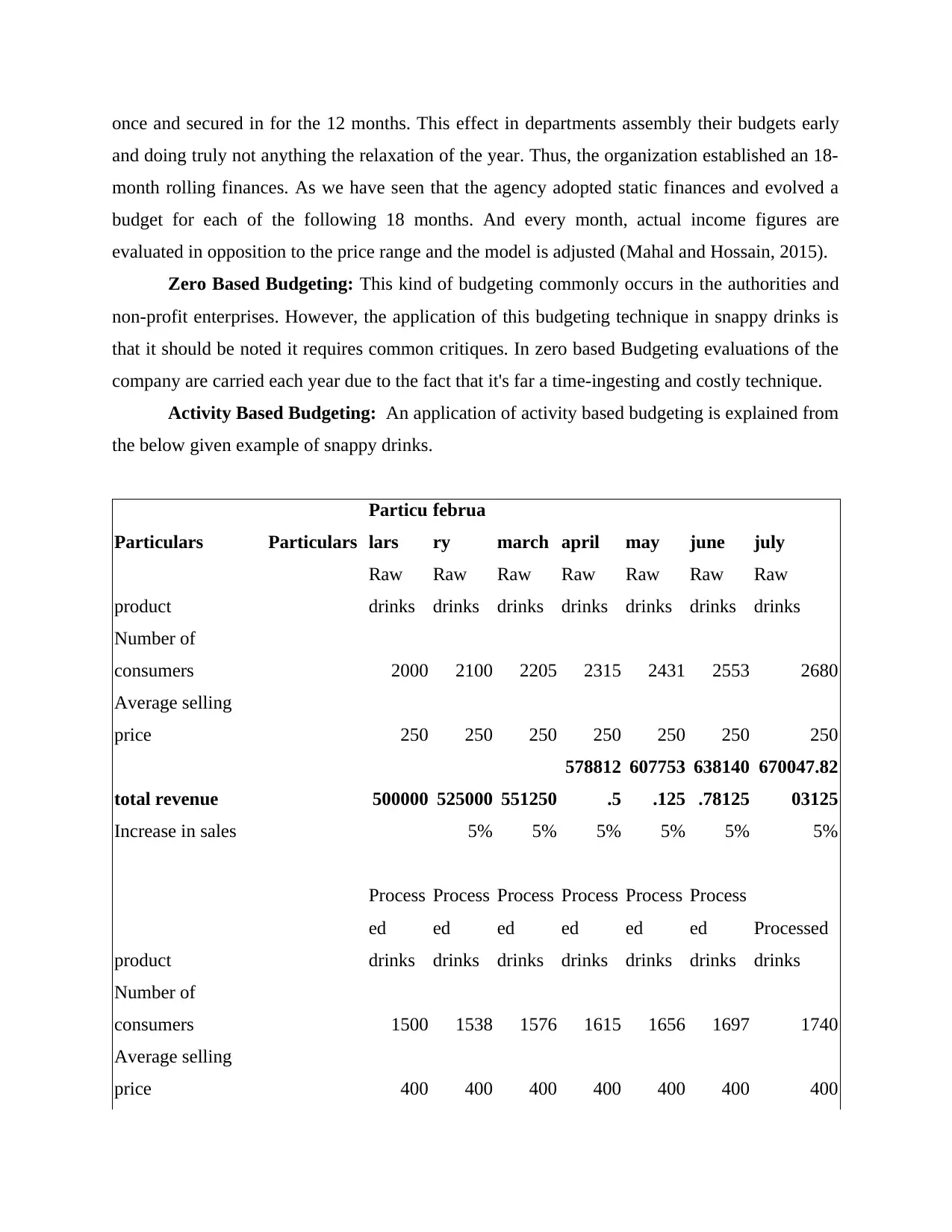
once and secured in for the 12 months. This effect in departments assembly their budgets early
and doing truly not anything the relaxation of the year. Thus, the organization established an 18-
month rolling finances. As we have seen that the agency adopted static finances and evolved a
budget for each of the following 18 months. And every month, actual income figures are
evaluated in opposition to the price range and the model is adjusted (Mahal and Hossain, 2015).
Zero Based Budgeting: This kind of budgeting commonly occurs in the authorities and
non-profit enterprises. However, the application of this budgeting technique in snappy drinks is
that it should be noted it requires common critiques. In zero based Budgeting evaluations of the
company are carried each year due to the fact that it's far a time-ingesting and costly technique.
Activity Based Budgeting: An application of activity based budgeting is explained from
the below given example of snappy drinks.
Particulars Particulars
Particu
lars
februa
ry march april may june july
product
Raw
drinks
Raw
drinks
Raw
drinks
Raw
drinks
Raw
drinks
Raw
drinks
Raw
drinks
Number of
consumers 2000 2100 2205 2315 2431 2553 2680
Average selling
price 250 250 250 250 250 250 250
total revenue 500000 525000 551250
578812
.5
607753
.125
638140
.78125
670047.82
03125
Increase in sales 5% 5% 5% 5% 5% 5%
product
Process
ed
drinks
Process
ed
drinks
Process
ed
drinks
Process
ed
drinks
Process
ed
drinks
Process
ed
drinks
Processed
drinks
Number of
consumers 1500 1538 1576 1615 1656 1697 1740
Average selling
price 400 400 400 400 400 400 400
and doing truly not anything the relaxation of the year. Thus, the organization established an 18-
month rolling finances. As we have seen that the agency adopted static finances and evolved a
budget for each of the following 18 months. And every month, actual income figures are
evaluated in opposition to the price range and the model is adjusted (Mahal and Hossain, 2015).
Zero Based Budgeting: This kind of budgeting commonly occurs in the authorities and
non-profit enterprises. However, the application of this budgeting technique in snappy drinks is
that it should be noted it requires common critiques. In zero based Budgeting evaluations of the
company are carried each year due to the fact that it's far a time-ingesting and costly technique.
Activity Based Budgeting: An application of activity based budgeting is explained from
the below given example of snappy drinks.
Particulars Particulars
Particu
lars
februa
ry march april may june july
product
Raw
drinks
Raw
drinks
Raw
drinks
Raw
drinks
Raw
drinks
Raw
drinks
Raw
drinks
Number of
consumers 2000 2100 2205 2315 2431 2553 2680
Average selling
price 250 250 250 250 250 250 250
total revenue 500000 525000 551250
578812
.5
607753
.125
638140
.78125
670047.82
03125
Increase in sales 5% 5% 5% 5% 5% 5%
product
Process
ed
drinks
Process
ed
drinks
Process
ed
drinks
Process
ed
drinks
Process
ed
drinks
Process
ed
drinks
Processed
drinks
Number of
consumers 1500 1538 1576 1615 1656 1697 1740
Average selling
price 400 400 400 400 400 400 400
⊘ This is a preview!⊘
Do you want full access?
Subscribe today to unlock all pages.

Trusted by 1+ million students worldwide
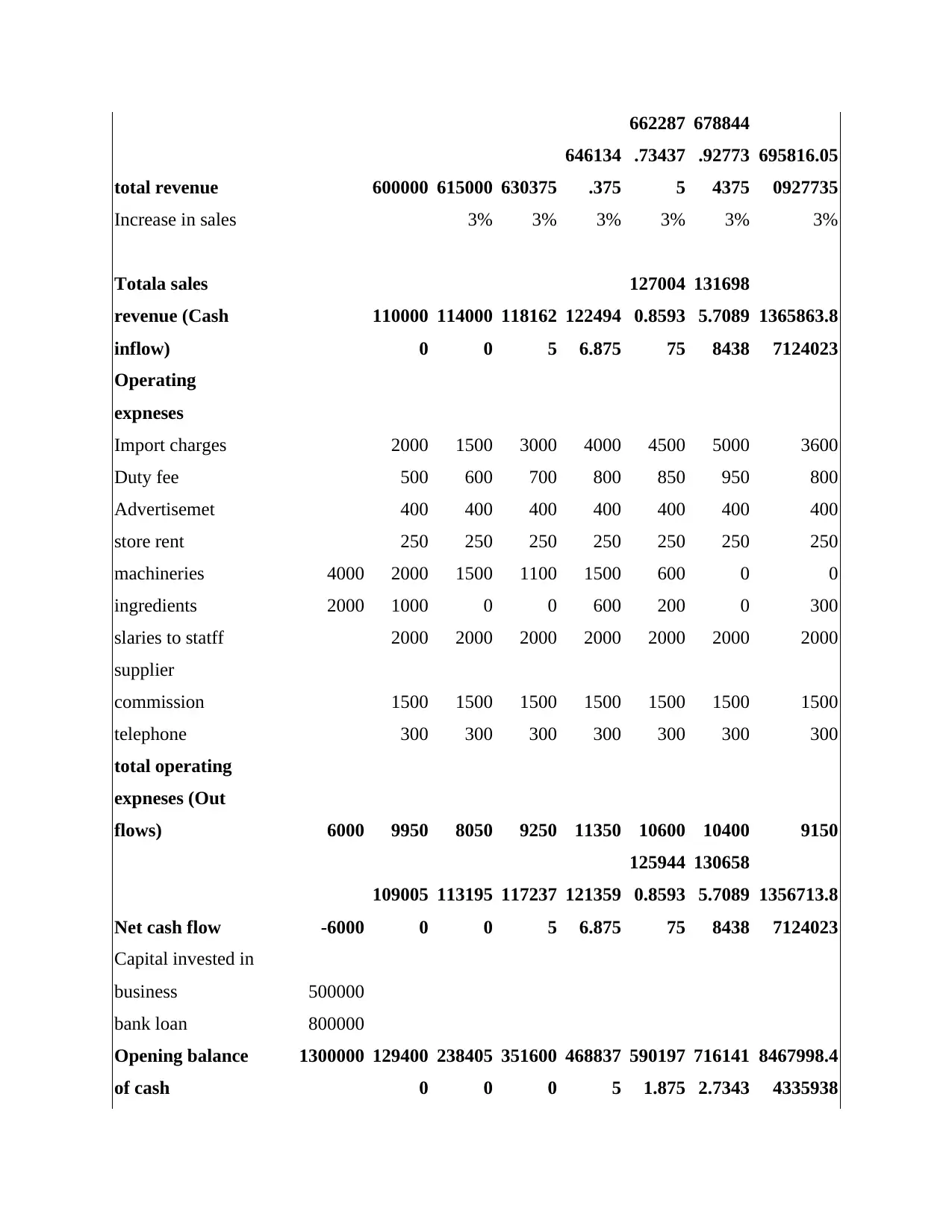
total revenue 600000 615000 630375
646134
.375
662287
.73437
5
678844
.92773
4375
695816.05
0927735
Increase in sales 3% 3% 3% 3% 3% 3%
Totala sales
revenue (Cash
inflow)
110000
0
114000
0
118162
5
122494
6.875
127004
0.8593
75
131698
5.7089
8438
1365863.8
7124023
Operating
expneses
Import charges 2000 1500 3000 4000 4500 5000 3600
Duty fee 500 600 700 800 850 950 800
Advertisemet 400 400 400 400 400 400 400
store rent 250 250 250 250 250 250 250
machineries 4000 2000 1500 1100 1500 600 0 0
ingredients 2000 1000 0 0 600 200 0 300
slaries to statff 2000 2000 2000 2000 2000 2000 2000
supplier
commission 1500 1500 1500 1500 1500 1500 1500
telephone 300 300 300 300 300 300 300
total operating
expneses (Out
flows) 6000 9950 8050 9250 11350 10600 10400 9150
Net cash flow -6000
109005
0
113195
0
117237
5
121359
6.875
125944
0.8593
75
130658
5.7089
8438
1356713.8
7124023
Capital invested in
business 500000
bank loan 800000
Opening balance
of cash
1300000 129400
0
238405
0
351600
0
468837
5
590197
1.875
716141
2.7343
8467998.4
4335938
646134
.375
662287
.73437
5
678844
.92773
4375
695816.05
0927735
Increase in sales 3% 3% 3% 3% 3% 3%
Totala sales
revenue (Cash
inflow)
110000
0
114000
0
118162
5
122494
6.875
127004
0.8593
75
131698
5.7089
8438
1365863.8
7124023
Operating
expneses
Import charges 2000 1500 3000 4000 4500 5000 3600
Duty fee 500 600 700 800 850 950 800
Advertisemet 400 400 400 400 400 400 400
store rent 250 250 250 250 250 250 250
machineries 4000 2000 1500 1100 1500 600 0 0
ingredients 2000 1000 0 0 600 200 0 300
slaries to statff 2000 2000 2000 2000 2000 2000 2000
supplier
commission 1500 1500 1500 1500 1500 1500 1500
telephone 300 300 300 300 300 300 300
total operating
expneses (Out
flows) 6000 9950 8050 9250 11350 10600 10400 9150
Net cash flow -6000
109005
0
113195
0
117237
5
121359
6.875
125944
0.8593
75
130658
5.7089
8438
1356713.8
7124023
Capital invested in
business 500000
bank loan 800000
Opening balance
of cash
1300000 129400
0
238405
0
351600
0
468837
5
590197
1.875
716141
2.7343
8467998.4
4335938
Paraphrase This Document
Need a fresh take? Get an instant paraphrase of this document with our AI Paraphraser
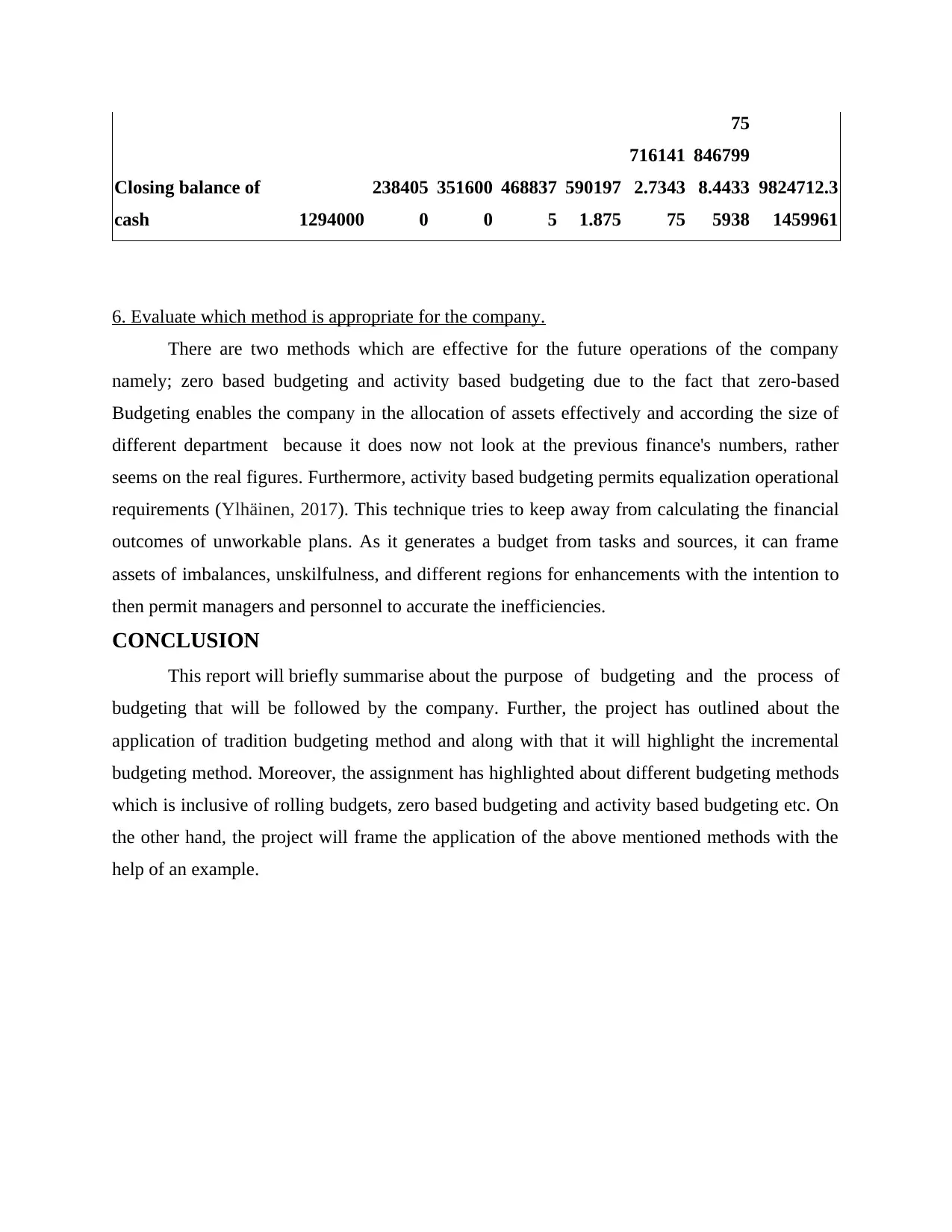
75
Closing balance of
cash 1294000
238405
0
351600
0
468837
5
590197
1.875
716141
2.7343
75
846799
8.4433
5938
9824712.3
1459961
6. Evaluate which method is appropriate for the company.
There are two methods which are effective for the future operations of the company
namely; zero based budgeting and activity based budgeting due to the fact that zero-based
Budgeting enables the company in the allocation of assets effectively and according the size of
different department because it does now not look at the previous finance's numbers, rather
seems on the real figures. Furthermore, activity based budgeting permits equalization operational
requirements (Ylhäinen, 2017). This technique tries to keep away from calculating the financial
outcomes of unworkable plans. As it generates a budget from tasks and sources, it can frame
assets of imbalances, unskilfulness, and different regions for enhancements with the intention to
then permit managers and personnel to accurate the inefficiencies.
CONCLUSION
This report will briefly summarise about the purpose of budgeting and the process of
budgeting that will be followed by the company. Further, the project has outlined about the
application of tradition budgeting method and along with that it will highlight the incremental
budgeting method. Moreover, the assignment has highlighted about different budgeting methods
which is inclusive of rolling budgets, zero based budgeting and activity based budgeting etc. On
the other hand, the project will frame the application of the above mentioned methods with the
help of an example.
Closing balance of
cash 1294000
238405
0
351600
0
468837
5
590197
1.875
716141
2.7343
75
846799
8.4433
5938
9824712.3
1459961
6. Evaluate which method is appropriate for the company.
There are two methods which are effective for the future operations of the company
namely; zero based budgeting and activity based budgeting due to the fact that zero-based
Budgeting enables the company in the allocation of assets effectively and according the size of
different department because it does now not look at the previous finance's numbers, rather
seems on the real figures. Furthermore, activity based budgeting permits equalization operational
requirements (Ylhäinen, 2017). This technique tries to keep away from calculating the financial
outcomes of unworkable plans. As it generates a budget from tasks and sources, it can frame
assets of imbalances, unskilfulness, and different regions for enhancements with the intention to
then permit managers and personnel to accurate the inefficiencies.
CONCLUSION
This report will briefly summarise about the purpose of budgeting and the process of
budgeting that will be followed by the company. Further, the project has outlined about the
application of tradition budgeting method and along with that it will highlight the incremental
budgeting method. Moreover, the assignment has highlighted about different budgeting methods
which is inclusive of rolling budgets, zero based budgeting and activity based budgeting etc. On
the other hand, the project will frame the application of the above mentioned methods with the
help of an example.
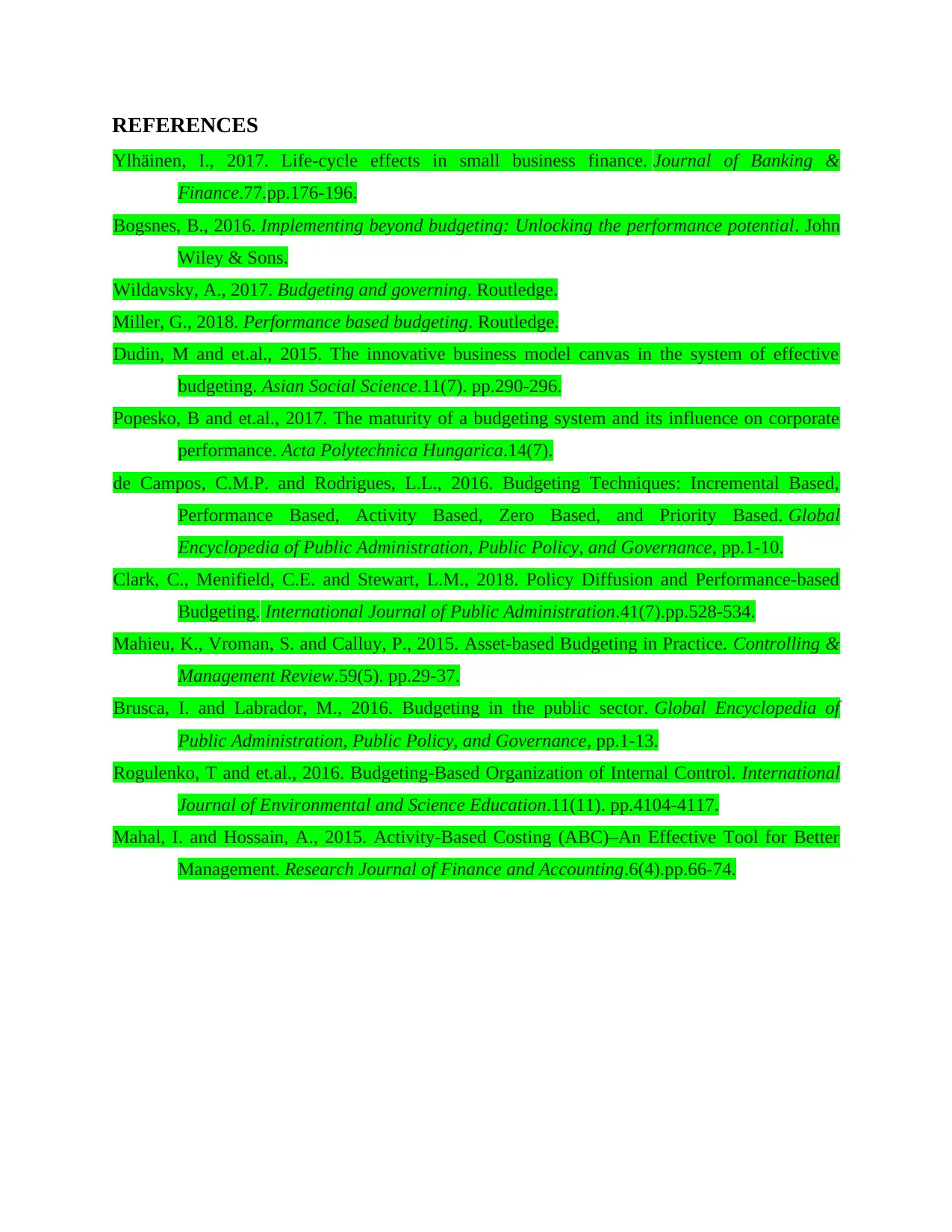
REFERENCES
Ylhäinen, I., 2017. Life-cycle effects in small business finance. Journal of Banking &
Finance.77.pp.176-196.
Bogsnes, B., 2016. Implementing beyond budgeting: Unlocking the performance potential. John
Wiley & Sons.
Wildavsky, A., 2017. Budgeting and governing. Routledge.
Miller, G., 2018. Performance based budgeting. Routledge.
Dudin, M and et.al., 2015. The innovative business model canvas in the system of effective
budgeting. Asian Social Science.11(7). pp.290-296.
Popesko, B and et.al., 2017. The maturity of a budgeting system and its influence on corporate
performance. Acta Polytechnica Hungarica.14(7).
de Campos, C.M.P. and Rodrigues, L.L., 2016. Budgeting Techniques: Incremental Based,
Performance Based, Activity Based, Zero Based, and Priority Based. Global
Encyclopedia of Public Administration, Public Policy, and Governance, pp.1-10.
Clark, C., Menifield, C.E. and Stewart, L.M., 2018. Policy Diffusion and Performance-based
Budgeting. International Journal of Public Administration.41(7).pp.528-534.
Mahieu, K., Vroman, S. and Calluy, P., 2015. Asset-based Budgeting in Practice. Controlling &
Management Review.59(5). pp.29-37.
Brusca, I. and Labrador, M., 2016. Budgeting in the public sector. Global Encyclopedia of
Public Administration, Public Policy, and Governance, pp.1-13.
Rogulenko, T and et.al., 2016. Budgeting-Based Organization of Internal Control. International
Journal of Environmental and Science Education.11(11). pp.4104-4117.
Mahal, I. and Hossain, A., 2015. Activity-Based Costing (ABC)–An Effective Tool for Better
Management. Research Journal of Finance and Accounting.6(4).pp.66-74.
Ylhäinen, I., 2017. Life-cycle effects in small business finance. Journal of Banking &
Finance.77.pp.176-196.
Bogsnes, B., 2016. Implementing beyond budgeting: Unlocking the performance potential. John
Wiley & Sons.
Wildavsky, A., 2017. Budgeting and governing. Routledge.
Miller, G., 2018. Performance based budgeting. Routledge.
Dudin, M and et.al., 2015. The innovative business model canvas in the system of effective
budgeting. Asian Social Science.11(7). pp.290-296.
Popesko, B and et.al., 2017. The maturity of a budgeting system and its influence on corporate
performance. Acta Polytechnica Hungarica.14(7).
de Campos, C.M.P. and Rodrigues, L.L., 2016. Budgeting Techniques: Incremental Based,
Performance Based, Activity Based, Zero Based, and Priority Based. Global
Encyclopedia of Public Administration, Public Policy, and Governance, pp.1-10.
Clark, C., Menifield, C.E. and Stewart, L.M., 2018. Policy Diffusion and Performance-based
Budgeting. International Journal of Public Administration.41(7).pp.528-534.
Mahieu, K., Vroman, S. and Calluy, P., 2015. Asset-based Budgeting in Practice. Controlling &
Management Review.59(5). pp.29-37.
Brusca, I. and Labrador, M., 2016. Budgeting in the public sector. Global Encyclopedia of
Public Administration, Public Policy, and Governance, pp.1-13.
Rogulenko, T and et.al., 2016. Budgeting-Based Organization of Internal Control. International
Journal of Environmental and Science Education.11(11). pp.4104-4117.
Mahal, I. and Hossain, A., 2015. Activity-Based Costing (ABC)–An Effective Tool for Better
Management. Research Journal of Finance and Accounting.6(4).pp.66-74.
⊘ This is a preview!⊘
Do you want full access?
Subscribe today to unlock all pages.

Trusted by 1+ million students worldwide
1 out of 12
Related Documents
Your All-in-One AI-Powered Toolkit for Academic Success.
+13062052269
info@desklib.com
Available 24*7 on WhatsApp / Email
![[object Object]](/_next/static/media/star-bottom.7253800d.svg)
Unlock your academic potential
Copyright © 2020–2025 A2Z Services. All Rights Reserved. Developed and managed by ZUCOL.




